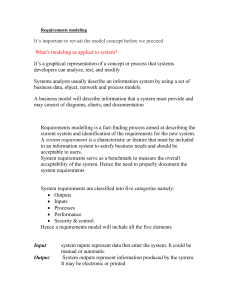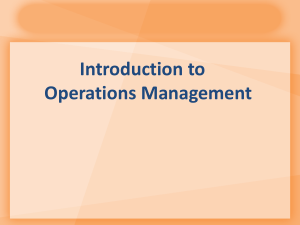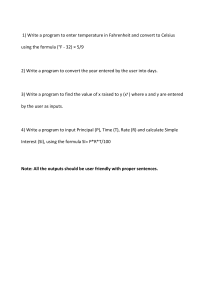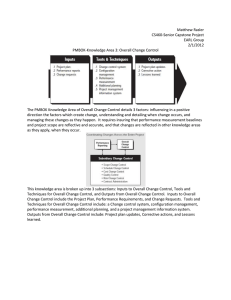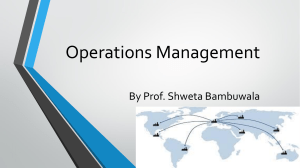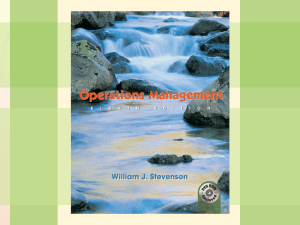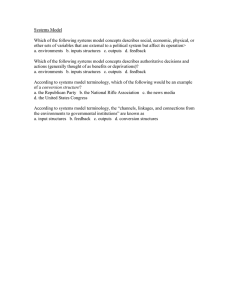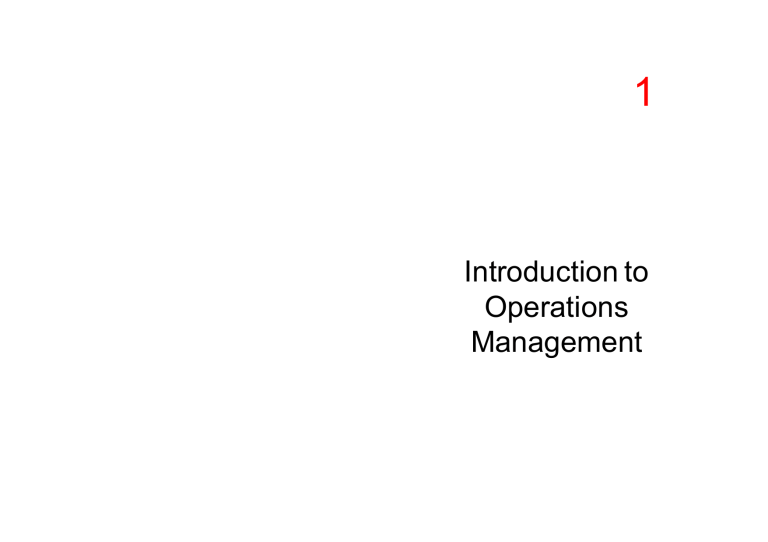
1 Introduction to Operations Management Learning Objectives Define the term operations management Basics of “Value Addition” Compare and contrast service and manufacturing operations Basics of “Goods-Services Continuum” Describe the operations function and the nature of the operations manager’s job Describe the key aspects of operations management decision making 1-2 Operations Management Managing that part of the organization responsible for producing goods and services Management of systems or processes that create goods and/or provide services Operations Examples Goods Producing Farming, mining, construction manufacturing, power generation Storage/Transport Warehousing, trucking, mail service, moving, taxis, ation buses, hotels, airlines Exchange Retailing, wholesaling, banking, renting, leasing, library, loans Entertainment Films, radio and television, concerts, recording Communication Newspapers, radio and television, newscasts, telephone, satellites 1-3 The Organization The Three Basic Functions Secure Fin. Resources OM in the news • • • • • Productivity Quality E-business Global Competition Customer Service Finance Budgeting Funding … Organization Operations Producing Assess Customer needs Competitiveness? Marketing Selling & Promoting … 1-4 Value-Added Process The operations function involves the conversion of inputs into outputs Value-added = Value or price of outputs – Cost of inputs 1-5 Value-Added Process The operations function involves the conversion of inputs into outputs Value added Inputs Land Labor Capital Transformation/ Conversion process Outputs Goods Services Feedback Control Feedback Feedback 1-6 Food Processor Inputs Processing Outputs Raw Vegetables Metal Sheets Water Energy Labor Building Equipment Cleaning Making cans Cutting Cooking Packing Labeling Canned vegetables Scraps! Hospital Process Inputs Processing Outputs Doctors, nurses Hospital Medical Supplies Equipment Laboratories Examination Surgery Monitoring Medication Therapy Healthy patients 1-7 Value-Added & Product Packages Value-added is the difference between the cost of inputs and the value or price of outputs. Product packages are a combination of goods and services. Product packages can make a company more competitive. 1-8 Goods-service Continuum Tangible Act Goods Service Surgery, teaching Song writing, software development Computer repair, restaurant meal Automobile Repair, fast food Home remodeling, retail sales Smart phones: Product/Service? Automobile assembly, steel making Product packages = Good(s) + service(s) Make a company more competitive- more value to customers 1-9 Production of Goods vs. Delivery of Services Production of goods – tangible output, production oriented Delivery of services – an act Service job categories Government Wholesale/retail Financial services Healthcare Personal services Business services Education 1-10 Goods vs Service: Key Differences Characteristic Goods Service Customer contact Uniformity of input Labor content Uniformity of output Low High Low High High Low High Low Output Measurement of productivity Opportunity to correct problems Inventory Evaluation Patentable Tangible Easy High Much Easier Usually Intangible Difficult Low Little Difficult Not usual 1-11 Challenges of Managing Services Service jobs are often less structured than manufacturing jobs Customer contact is higher Worker skill levels are [relatively] lower Services hire many low-skill, entry-level workers Employee turnover is higher Input variability is higher Service performance can be affected by worker’s personal factors 1-12 Scope of Operations Management Operations Management includes: Forecasting Capacity planning Scheduling Managing inventories Assuring quality Motivating employees Deciding where to locate facilities Supply chain management And more . . . 1-13 Key Decisions of Operations Managers What What resources/what amounts When Needed/scheduled/ordered Where Work to be done How Designed Who To do the work 1-14 Decision Making System Design System operation – capacity – personnel – location – inventory – arrangement of departments – product and service planning – scheduling – project management – acquisition and placement of equipment – quality assurance 1-15 Quantitative Approaches • Linear programming • Queuing Techniques • Inventory models • Project models • Statistical models 1-16 Analysis of Trade-Offs Decision on the amount of inventory to stock Customer Cost Increased cost of holding inventory Vs. Level of customer service 1-17 Systems Approach “The whole is greater than the sum of the parts.” Suboptimization 1-18 Trends in Business Major trends The Internet, e-commerce, e-business Management technology Globalization Management of supply chains Outsourcing Agility Ethical behavior 1-19 Other Important Trends Ethical behavior Operations strategy Working with fewer resources Revenue management Process analysis and improvement Increased regulation and product liability Lean production Combination of Mass Production (high volume, low unit cost) and Craft Production (variety and Flexibility) 1-20

